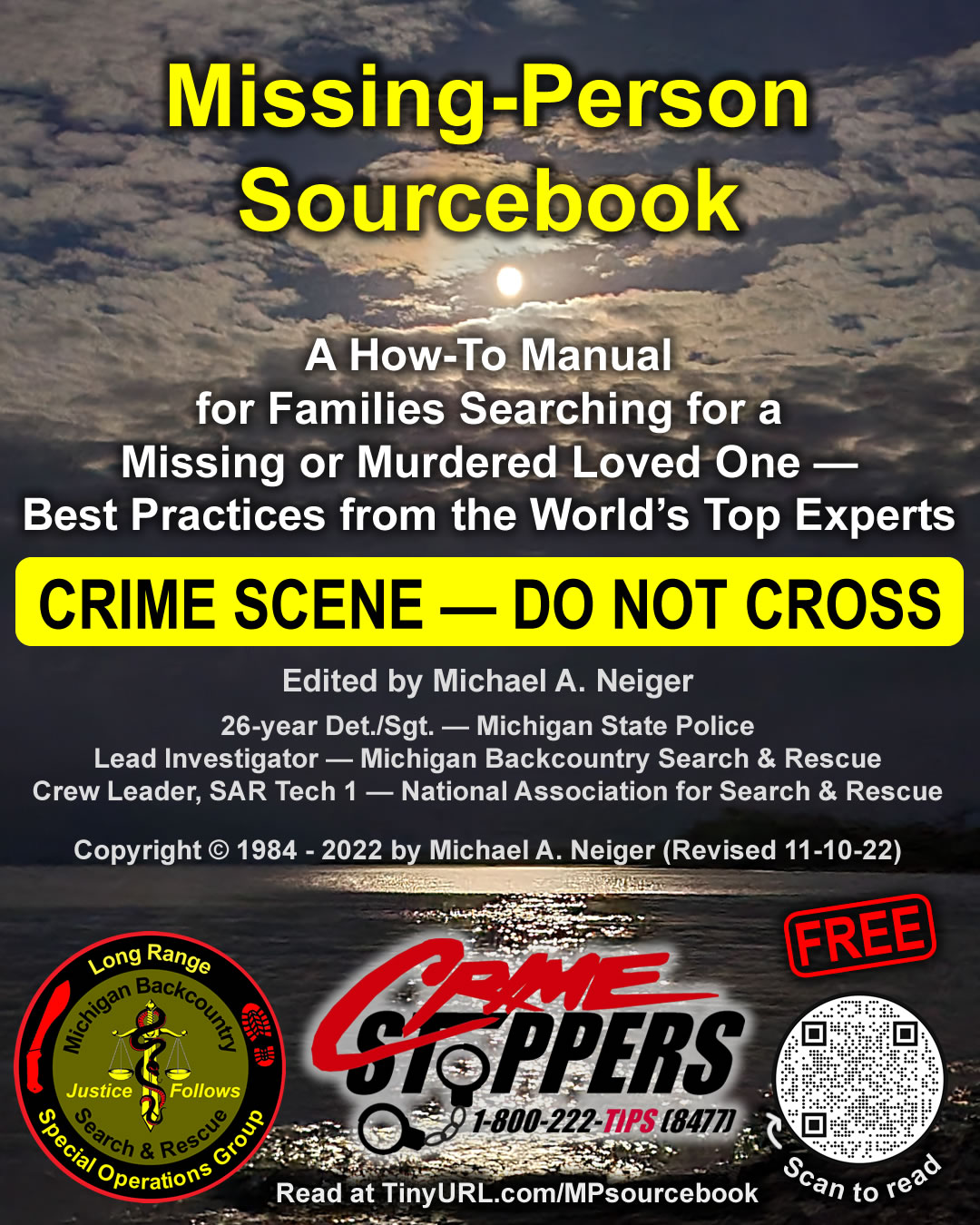
You're here: MibSAR :: M-P Sourcebook Table of Contents :: Evidence
What to Do With Evidence the Police Won't Accept
| << Prior Chapter | Next Chapter >> |
If the investigator in charge of your loved one's missing-person or murder investigation won't accept an item of potential evidence from you, don't give up and discard it. Preserve it as best you can until your loved one's case is fully and satisfactorily closed.
As more is learned about your case in the months or years to come, the evidence may become relevant, and forensic analysis of it may be needed. And keep in mind that investigators transfer, get promoted, or retire, and a fresh set of eyes on your case, especially by someone with fire in his or her belly, may change the importance of the item.
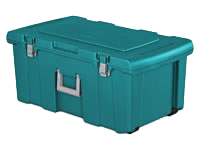 |
|
| A $20.00 lockable Sterilite Footlocker from Walmart | |
One of the best ways to preserve evidence is to place the item in a clean, unused, brown paper bag, securing the opening with sticky tape and staples.
With an indelible marker, label the bag with: a description of its contents; the victim's name; the date and time secured in the paper bag; the name of the person securing the evidence in the bag; the date, time, and location where the item was originally found, and the name of the person who found it.
Before packaging an item, take a couple pictures of it, and make sure it is absolutely dry, otherwise it may mold, which could destroy its potential evidentiary value. Also, always wear clean, unused rubber gloves so you are not contaminating the evidence with your finger prints, DNA (skin cells, hair, bodily fluids), etc.
To avoid cross-contamination, avoid putting two or more items in the same paper bag. Because paper bags are breathable, and will release any moisture, they are generally preferable to plastic bags that trap moisture, which often leads to mold.
Once the item is properly documented, packaged, and labeled, secure it in a large lockable footlocker for safe storage. Store the locked footlocker in a dry, secure area.
This chain-of-custody process — properly documenting, packaging, labeling, securing, and storing potential items of evidence — will go a long way to keeping evidence specimens available for forensic or other analysis in the future as well as helping to increase the chances they will be admissible in a court of law.
Detailed information on how to collect and preserve specific types of evidence can be found in the free, forensic manuals listed below.
Page contents:
- Handbook of Forensic Services, by the Laboratory Division, Federal Bureau of Investigation (FBI), 2019, 104 pages.
- Evidence Handbook, by Wisconsin Department of Justice, Division of Forensic Sciences, 11th edition, 2024, 258 pages.
- Handbook of Forensic Evidence for the Investigator, by the Centre of Forensic Sciences, Public Safety Division, Ministry of Community Safety and Correctional Service, Ontario, Canada, 2022, 41 pages.
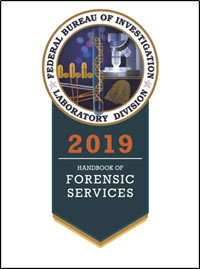 |
|
| Handbook of Forensic Services, by the Laboratory Division, Federal Bureau of Investigation (FBI) | |
This handbook provides guidance and procedures for safe and efficient methods of collecting, preserving, packaging, and shipping evidence.
It also describes the forensic examinations performed by the FBI’s Laboratory Division.
Contents:
- Table of Contents
- Introduction
- FBI Forensic Services
- Additional Case Acceptance Guidelines
- Submitting Evidence
- Requesting Evidence Examinations
- Packaging and Shipping Evidence
- Evidence Examinations And Services
- Forensic Facial Imaging
- Gambling Device Examinations
- Gambling Records Examinations
- GIS Mapping And Aerial Photograph
- Glass Examinations
- Graphic Arts (Commercial And Office Printing) Examinations
- Hair Examinations
- Handwriting And Hand Printing Examinations
- Human Smuggling Records Examinations
- Ink Examinations
- Known Handwriting Instructions
- Laboratory Shooting Reconstruction Team
- Latent Print (Friction Ridge) Examinations
- Liquid Soaked Document Preservation
- Loan Records Examinations
- Lubricant Examinations
- Metallurgy Examinations
- Muzzle-To-Target Distance Determination
- National DNA Index System/Combined DNA Index System
- National Integrated Ballistic Information Network (NIBIN)
- National Missing Person DNA Database (NMPDD) Program
- Packaging Examinations
- Paint Examinations
- Paper Examinations
- Paper Reconstruction
- Pepper Spray Examinations
- Pharmaceutical Examinations
- Photocopy Or Facsimile Examinations
- Photo Processing
- Plastic Bag Examinations
- Polymer Examinations
- Post-Mortem Forensic Facial Imaging
- Product Tampering Examinations
- Prostitution Records Examinations
- Radioactive Materials Examinations
- Rope or Cordage Examinations
- Rubber Stamp Examinations
- Safe Insulation Examinations
- Serial Number (Altered) Examinations
- Soil Examinations
- Special Event And Situational Awareness Support
- Symbol Examinations
- Tape Examinations
- Threatening Communication Database
- Toolmark Examinations
- Toxicology Examinations
- Typewriting Examinations
- Unknowns (General Chemical) Examinations
- Weapons Of Mass Destruction/CBRN Examinations
- Crime Scene Safety
- Routes of Exposure
- Safety
- Personal Protective Equipment
- Hazardous Materials Transportation
- Hazardous Waste Regulations
- References
- Index
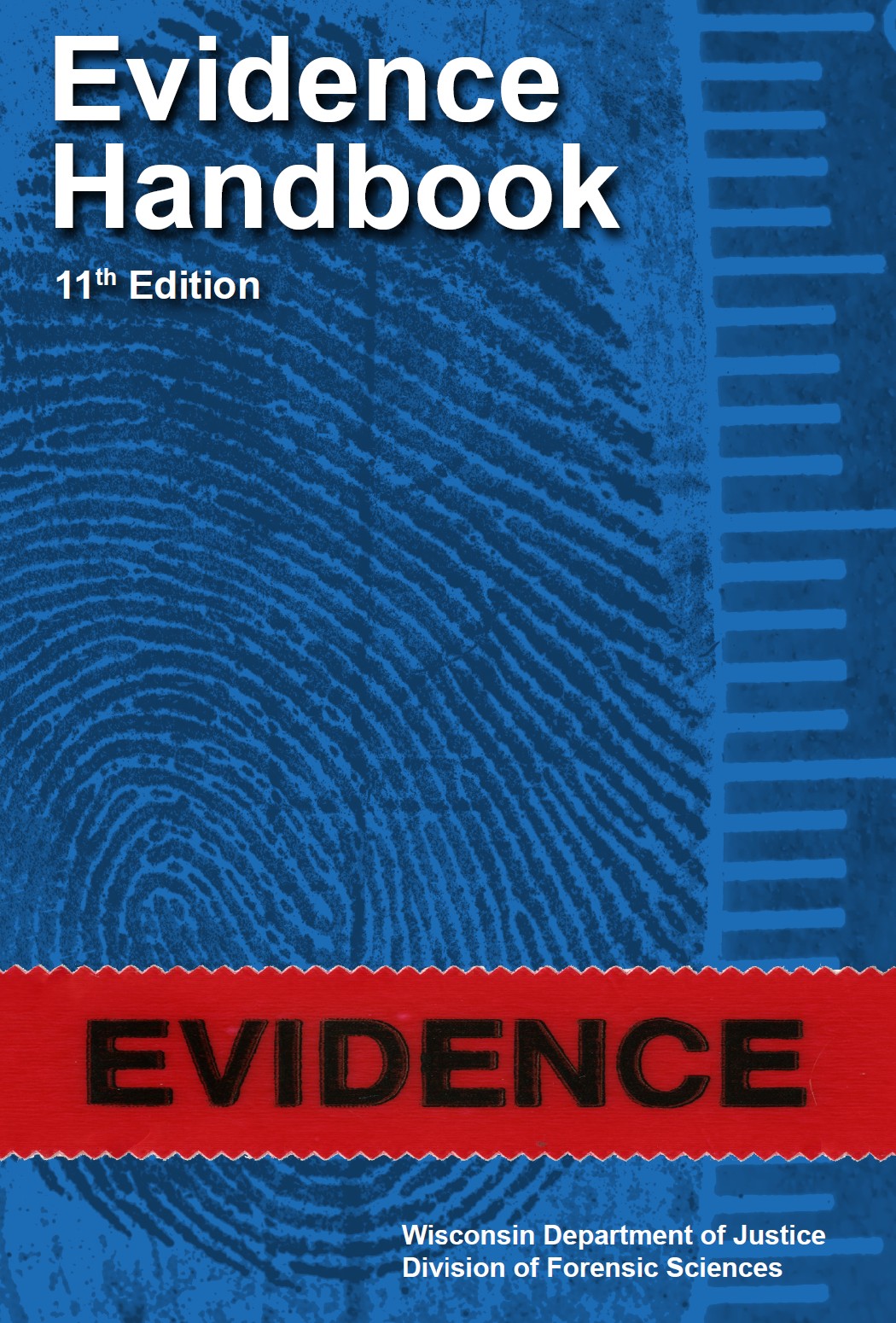 |
|
| Evidence Handbook, by the Wisconsin Department of Justice, Division of Forensic Sciences | |
This handbook is offered in the belief that increased knowledge leads to understanding and that understanding leads to excellence.
It describes the types of evidence the Wisconsin Crime Laboratories forensically analyze.
Contents:
- Introduction
- Evidence Integrity
- Forensic Photography
- Video and Audio Recordings
- Crime Scene Sketch
- Bloodstain and Pattern Analysis
- DNA Evidence and Standards
- Sexual Offenses
- DNA Databank
- Questioned Documents
- Firearms and Ammunitions
- Footwear and Tire Examinations
- Footwear and Tire Impressions
- Latent Prints
- Major Case Prints
- Automated Fingerprint Identification
System (AFIS)
- Burglary
- Building Materials
- Glass
- Tool Marks
- Paints
- Metals
- Clothing and Fabrics
- Hairs and Fibers
- Woods and Sawdust
- Fracture and Tear Matches
- Vehicles
- Autopsy
- Identification of Unknown Deceased
- Dental Identification of Human Remains
- Toxicology
- Poisoning
- Controlled Substances
- Arson
- Explosives, Bombs and Fireworks
- Appendix - Bloodborne Pathogens
- Appendix - Collection Kits
- Appendix - Evidence Submission Guidelines
- Index
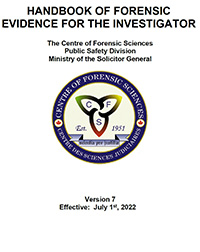 |
|
| Handbook of Forensic Evidence for the Investigator, by the Centre of Forensic Sciences | |
This handbook provides an overview of the collection and packaging requirements for items being submitted to Centre of Forensic Sciences laboratories.
Contents:
- General Information
- Documentation
- Collection and packaging of evidence items
- Druggist’s fold for collecting trace samples
- Adhesive tape
- Comparison samples
- Comparison samples
- Ammunition
- Unfired
- Fired Comparison samples
- Rapid assessment for IBIS selection examination (RAISE) cases
- Biology DNA High Volume Service
- Blood alcohol kits (BAKs)
- Bloodstains
- Wet/dry stains on a non-absorbant surface
- Wet/dry stains on an absorbant surface Comparison samples
- Body tissues/post-mortem samples (other than lung)
- Comparison samples
- Comparison samples
- Bones/teeth
- Comparison samples
- Comparison samples
- Building materials (plaster, concrete, insulation)
- Questioned samples
- Comparison samples
- Chemical, biological, radiological and nuclear (CBRN) materials
- Chewing gum
- Comparison samples
- Comparison samples
- Cigarette butts
- Comparison samples
- Comparison samples
- Clothing – for analysis of blood, saliva, semen and DNA analysis
- Comparison samples
- Comparison samples
- Clothing – for damage analysis
- Comparison samples
- Comparison samples
- Clothing – for gunshot residue analysis, see “GSR – on clothing”
- Clothing – for trace analysis (e.g. glass, paint, hairs and fibres)
- Clothing – for analysis of volatile ignitable liquids
- Comparison samples
- Comparison samples
- Condoms
- Comparison samples
- Comparison samples
- Controlled substances
- Comparison samples
- Comparison samples
- Cosmetics
- Comparison samples
- Comparison samples
- Counterfeit bank notes
- DNA High Volume Service
- DNA samples – for comparison purposes
- Blood samples collected by finger-prick
- Pulled hairs
- Oral/buccal swab
- Atypical samples
- Reference/personal effect samples
- Discard samples
- DNA samples – for comparison purposes
- DNA samples – obtained by warrant
- DNA samples – obtained by consent
- Dye-pack dye (MAAQ)
- Drug and alcohol analysis
- Envelope flaps and stamps
- Comparison samples
- Comparison samples
- Explosives
- Fibres
- Comparison samples
- Comparison samples
- Fingernail clippings and scrapings
- Clippings
- Scrappings
- Comparison samples
- Fingerprinting
- Fire debris
- Comparison samples
- Comparison samples
- Firearm discharge residue – distance determination
- On clothing
- On tissue
- Comparison samples
- Firearms
- Forensic cases
- Comparison samples
- Suspicious Firearms Index (SFI) cases
- Food
- Food for DNA analysis
- Comparison samples
- Gases
- Comparison samples
- Comparison samples
- Glass
- On clothing and footwear
- Loose particles
- Comparison samples
- Other glass examinations
- Gunshot residue (GSR)
- GSR - on hands
- GSR - on vehicles
- GSR - on clothing
- Comparison samples
- Hairs
- Comparison samples
- Comparison samples
- Handler DNA
- Comparison samples
- Comparison samples
- Handwriting, handprinting and signatures
- Comparison samples
- Comparison samples
- High Volume Service
- Indented writings
- Ink comparisons
- Lachrymators (Mace, pepper spray, tear gas)
- Letter of opinion (Toxicology Section)
- Lungs
- Comparison samples
- Comparison samples
- Maggots
- Metals
- Comparison samples
- Comparison samples
- Noxious substances (acids, bases, bleach, etc.)
- Questioned samples
- Comparison samples
- Clothing
- Paint
- Questioned and comparison samples
- Questioned and comparison samples
- Printing machines (cheque protectors/writers, computer printers, fax machines, photocopiers, typewriters)
- Penile swabs
- Saliva
- Comparison samples
- Comparison samples
- Semen
- Comparison samples
- Comparison samples
- Serial numbers
- Sexual assault evidence kit (SAEK)
- Comparison samples
- Comparison samples
- Sexual lubricants
- Comparison samples
- Comparison samples
- Suspicious liquids or powders
- Syringes
- Comparison samples
- Comparison samples
- Toolmarks
- Comparison samples
- Comparison samples
- Tools
- Vehicles
- Weapons (knives, scissors, etc.)
- Comparison samples
- Comparison samples
| << Prior Chapter | Next Chapter >> |
People who say it cannot be done,
should not interrupt those who are doing it.
— Author unknown
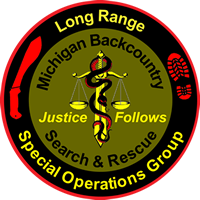
If you've been able to read this
Web page...
thank a Teacher;
If you've been able to read this
Web page in English...
thank a Veteran.
— Author unknown
Copyright © 1984-
March 22, 2025
by Michael A. Neiger
Contact Michael Neiger via e-mail at mneiger@hotmail.com
Top
You're here: MibSAR :: M-P Sourcebook Table of Contents :: Evidence